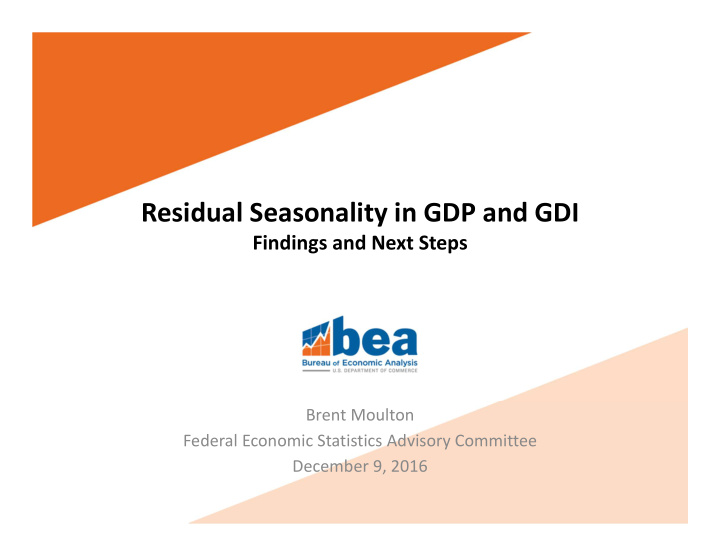



Residual Seasonality in GDP and GDI Findings and Next Steps Brent Moulton Federal Economic Statistics Advisory Committee December 9, 2016
Overview • Overview of current seasonal adjustment methodology for national income and product accounts: – Gross domestic product (GDP) – Gross domestic income (GDI) • Test components and aggregates for residual seasonality • Determine major causes of residual seasonality • Discuss strategies for removing residual seasonality and improving seasonal adjustment methods 2 12/5/2016
Background • U.S. national income and product accounts – Macroeconomic time series including GDP, GDI – Estimated from various source data – Compilation based on accounting framework – Annual estimates (since 1929) – Quarterly, seasonally adjusted estimates (since 1947) – Limited not seasonally adjusted (NSA) GDP estimates were formerly compiled separately, but project ended in 2008 due to budget cuts • In early 2015, reports of residual seasonality in GDP related to weakness in first quarter growth 3 12/5/2016
Gross Domestic Product, NSA (discontinued) 4,000 Gross Domestic Product, 3,500 not seasonally adjusted (current dollars) 3,000 (discontinued series) 2,500 Billions of dollars 2,000 1,500 1,000 500 0 92q1 93q1 94q1 95q1 96q1 97q1 98q1 99q1 00q1 01q1 02q1 03q1 04q1 05q1 06q1 Quarter 4 12/5/2016
Gross Domestic Product, 1992 ‐ 2006 4,000 Gross Domestic Product 3,500 July 2007 vintage estimates (current dollars, quarterly rates) 3,000 (NSA series is discontinued) 2,500 Billions of Dollars 2,000 1,500 1,000 500 0 92q1 93q1 94q1 95q1 96q1 97q1 98q1 99q1 00q1 01q1 02q1 03q1 04q1 05q1 06q1 Not Seasonally Adjusted Seasonally Adjusted 5 12/5/2016
NIPA seasonal adjustment methodology • Possible approaches: Direct versus Indirect • Direct approach – Estimate not seasonally adjusted (NSA) components from NSA source data. Aggregate, then seasonally adjust aggregate GDP as final step – Problem – difficult to explain seasonally adjusted GDP based on source data and components • Indirect approach – Estimate seasonally adjusted (SA) components directly from SA source data, then aggregate • If source data are seasonally adjusted by source agency, retain its seasonal adjustments • Otherwise, source data seasonally adjusted by BEA staff – Problem – potential residual seasonality • BEA’s long ‐ standing practice is to use the indirect approach 6 12/5/2016
Component review • Goal – Identify and investigate causes of residual seasonality in order to propose solutions • Methodology – Examined 2,000 GDP component data series for • Current dollars • Real (chained 2009 dollars) • Price indexes – Used X ‐ 12 ARIMA • F test for stable seasonality • M7 statistic • 10, 15, and 30 year periods 7 12/5/2016
Results of tests • Results sensitive to period selected • Real GDP exhibited residual seasonality over 10 ‐ year and 30 ‐ year spans • Several real GDP components also exhibited residual seasonality over certain spans – Investment in nonresidential structures – Exports of goods – Federal government spending – State and local government spending • GDP price index exhibited residual seasonality over 30 ‐ year span, as did several components • GDI did not exhibit residual seasonality 8 12/5/2016
Causes of residual seasonality Two main factors causing residual seasonality were identified: 1. Use of monthly source data to estimate quarterly GDP components – Monthly series may not exhibit seasonality and isn’t seasonally adjusted, but seasonal when aggregated to quarterly frequency – Or , series that is seasonally adjusted at monthly frequency may exhibit residual seasonality when aggregated to quarterly frequency – Solution involves examining series at both monthly and quarterly frequency 9 12/5/2016
Causes of residual seasonality 2. Revisions to seasonal adjustment factors not shown consistently in time series due to revision practices that limit the number of years open to revision Moving averages – new data lead to revisions in seasonal – factors for several years BEA national income and product accounts traditionally – revise most recent 3 years except for comprehensive (benchmark) updates Some Census indicators only revise SA estimates for – years with revised annual data Solution involves changing revision practices to allow – revisions to SA estimates for longer periods 10 12/5/2016
Causes of residual seasonality (minor) Other, less common factors also contribute to residual seasonality for certain components: 3. By convention, certain series related to government policy haven’t been seasonally adjusted (e.g. federal pay raises). 4. Residual seasonality may arise as a result of estimation processes, such as commodity flow, aggregation, or deflation, even when input series are seasonally adjusted. These problems can be identified and corrected by modifying BEA estimation processes. 11 12/5/2016
Plan for addressing residual seasonality • BEA has used findings of this review to modify seasonal adjustments for recent years – Began seasonally adjusting component series that previously hadn’t been adjusted • Series within federal defense spending, consumer spending on services, inventory investment – Began modifying methodologies, for example to seasonally adjust certain series at quarterly frequency – Interagency seasonal adjustment team (with Census and BLS) • For July 2018 comprehensive update, the historical time series will be revised to remove identifiable residual seasonality 12 12/5/2016
Reintroduce NSA estimates • Starting in 2018, BEA will begin producing and publishing NSA estimates of GDP and its major components. • In contrast to old discontinued program, these NSA estimates will be – Released concurrently with quarterly GDP – Include estimates of real GDP and price indexes • Will allow comparisons of direct and indirect approaches to seasonal adjustment 13 12/5/2016
Recommend
More recommend